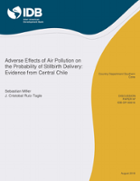Adverse Effects of Air Pollution on the Probability of Stillbirth Delivery: Evidence from Central Chile
Date
Aug 2018
This paper examines the effect of exposure to air pollution on the probability of a pregnancy ending in a stillbirth delivery. We use official registry data of pregnancy outcomes and municipality-week level data on PM10 and CO air pollution concentrations for 84 municipalities in Chile over the period 2008-2015. Using a hazard function approach to account for time at risk throughout the duration of pregnancies, we find that acute exposure to PM10 and CO pollution has a significant adverse effect on the probability of stillbirth delivery, and find no significant effect of chronic exposure to these pollutants. For a stillbirth rate of 5.7 per every thousand pregnancies in our sample, we find that a one-standard-deviation increase in acute exposure to PM10 pollution (S.D.=23.34) results in a 10.5 percent increase in the probability of stillbirth. Similarly, a one-standard-deviation increase in acute exposure to CO pollution (S.D.=.54) results in a 5.3 percent increase in probability of stillbirth. Furthermore, we further examine the most likely pathway in which air pollution adversely affects a fetal death that results in stillbirth delivery (via lack of oxygen flowing to the fetus that may eventually result in a stillbirth due to hypoxia). We find indeed larger effects of acute exposure to air pollution (both PM10 as well as CO) on the probability of stillbirth due to hypoxia.



